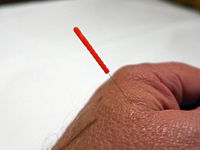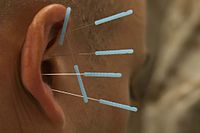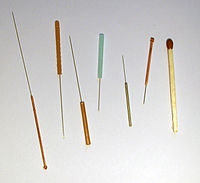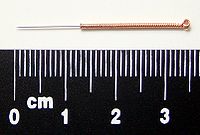Acupuncture
![]()
This article is about the healing method. For the music album, see Acupuncture (album).
Acupuncture (from Latin acus = needle, and punctura < pungere = to prick; Chinese 針灸 / 针灸, Pinyin zhēnjiǔ, Jyutping zam1gau3) is a treatment method of traditional Chinese medicine (TCM), in which a therapeutic effect is to be achieved by needle pricks at certain points of the body. The traditional form of acupuncture, which has been practiced in China and Japan since the 2nd century B.C., is based on the assumption that there is a "life energy of the body" (Qi) that circulates along defined pathways or meridians and is supposed to have a controlling influence on all bodily functions. A disturbed flow of energy is said to cause illnesses and the disturbance in the flow of Qi is supposed to be remedied by pricks in acupuncture points located on the meridians. Acupressure by applying blunt pressure and moxibustion by applying heat to acupuncture points have the same therapeutic goal.
The most extensive clinical studies of acupuncture to date have been the GERAC studies. In these, a better effect of acupuncture and sham acupuncture was found for chronic low back pain and chronic knee pain in gonarthrosis in a non-blinded comparison with standard guideline-oriented therapy. No effect distinguishing acupuncture from sham acupuncture (comparison group) was demonstrated. Other studies also show that sham acupuncture (a superficial acupuncture stabbed to a maximum depth of 3 mm and without needle stimulation at points in the same area of the body) has the same effect as acupuncture performed according to traditional rules. Acupuncture is used to treat many other ailments, but there is weak evidence of effectiveness for only a few applications.
At the German Medical Congress in 2003, the additional further training in acupuncture was newly introduced into the (model) further training regulations (MWBO) of the German Medical Association. In the EU, there were an estimated 96,380 users of acupuncture in 2012, 80,000 of whom were physicians.
Acupuncture needles, for size comparison with a matchstick
Acupuncture needle (short)
Acupuncture needle (long) in packaging
Historical
→ Main article: History of acupuncture
The oldest known written reference to acupuncture and moxibustion (Chinese 針灸, Pinyin zhēn jiǔ - "acupuncture and moxibustion") dates back to the second century BC. The Chinese historian Sima Qian first mentions stone needles in his records. The oldest collection of Chinese medical writings, the Inner Classic of the Yellow Emperor (Huangdi Neijing) from the period between 200 years before and after the turn of time, gives the first overview of the pricking and burning therapies of the time and describes different needles (made of metal), various pricking techniques and gives indications for the use of certain points. A total of 160 points are described.
The first work on acupuncture that can be dated with certainty is The Systematic Canon of Pricking and Burning (Zhenjiu jiayijing) by Huangfu Mi (215-282). The author describes in clear terminology 349 acupuncture points and gives systematic indications of their effects. Other significant writings are the explanations of the 14 main pathways by Hua Boren (1341), the studies on the eight unpaired pathways by Li Shizhen (1518-1593), and the sum of acu-moxi therapy by Yang Jizhon (1601).
Already in the late 16th and early 17th century Portuguese Jesuits mentioned burning with moxa and needle therapy in letters from Japan. In the 17th and 18th centuries acupuncture was made known in Europe especially by two doctors of the Dutch East India Company: Willem ten Rhijne and Engelbert Kaempfer. While experimenting with moxa as a supposed variant of classical burning therapies, misleading formulations by ten Rhijne and Kaempfer led to the rejection of these forms of therapy by influential physicians such as Lorenz Heister and Georg Ernst Stahl.
The first known acupuncture treatment in Europe was carried out in 1810 by the physician Louis Berlioz, the father of the composer Hector Berlioz. He reported on it in a prize pamphlet published in 1816. From 1819 - mainly around 1825 under Jules Cloquet and Frederik Liubenstein - fading out in the 1830s - acupuncture became a frequently used form of therapy, even fashionable therapy, in France. The French practice was taken up in England in 1821 by the physician James Morss Churchill. In 1825 Johann Wilhelm von Wiebel accompanied his King Frederick William IV on a state visit to Paris and reported on his impressions of acupuncture practice in Paris. In the same year, the military doctor and neurologist Jean-Baptiste Sarlandière published a treatise on "Electropuncture" to which he appended two Japanese manuscripts from the estate of Isaac Titsingh. In the USA, too, from 1825 onwards, doctors wrote about their own experiences with acupuncture, following the French and English example.
The anesthesia performed in China during the early 1970s as an alleged alternative procedure to anesthesia caused a worldwide sensation and heated debate. After the Vietnam War, the US military made inquiries about the benefits of acupuncture anesthesia. As late as 2012, the U.S. military was funding acupuncture studies.
The majority of the publications of the Chinese Medical Association describe scientific medicine and not traditional methods, such as acupuncture.

Guideway plate in a Japanese edition of Hua Shou's Shisi jing fahui, Edo 1716
Suspected mechanisms of action
According to traditional Chinese medicine
Classical acupuncture is based on the doctrine of yin and yang, which was later supplemented by the five elements doctrine and the doctrine of meridians. It uses three procedures:
- Insertion of needles into the acupuncture points
- Heating of the points (moxibustion)
- Massage of the points (Tuina, acupressure)
In acupuncture, about 400 acupuncture points are used, which are located on the so-called meridians. To simplify matters, the nowadays common model of twelve main meridians, each of which is laid out in mirror image in pairs on both sides of the body, was introduced. Eight extra meridians and a number of so-called extra points complement this model. According to the model of traditional Chinese medicine, the flow of Qi (life energy) is influenced by the insertion of the needles. The term "meridian", introduced by George Soulié de Morant, is misleading as it does not refer to projection lines. The underlying Chinese term jingluo should be translated as "tracts and channels". According to this understanding, acupuncture belongs to the redirection and regulation therapies.
Since the mechanisms of action assumed by traditional Chinese medicine could not be scientifically proven, these even contradict established knowledge about the function and structure of the human body, and no other mechanism of action can be proven, the placebo effect is often held responsible for the effectiveness. These and similar results from other areas of alternative medicine have led to an increased discussion about how the effect can be better exploited in conventional medicine as well.
According to scientific medicine
From the point of view of some natural scientists, the principle of action of acupuncture is based on the stimulation of certain body points, possibly influencing the regulation of the body. One study measured increased endorphins in the cerebrospinal fluid after electrical stimulation of certain acupuncture points. The molecule adenosine may play an important role in the effects of acupuncture needles. In 2010, neuroscientists reported that in the immediate vicinity of the needle pricks, the adenosine content in the tissue had increased several times. Exactly what goes on in the body during acupuncture has yet to be elucidated. A consensus on how acupuncture might work does not exist.
From the point of view of other scientists, acupuncture is an elaborate placebo. They point out that the outcome of a treatment with acupuncture does not depend on where or whether a needle is inserted (sham or fake acupuncture). Since this is core to acupuncture, they conclude that acupuncture does not work. Much of the apparent improvement can be explained by regression to the mean. They also point out that studies of acupuncture partly involve electroacupuncture, which is just transcutaneous electrical nerve stimulation by another name.
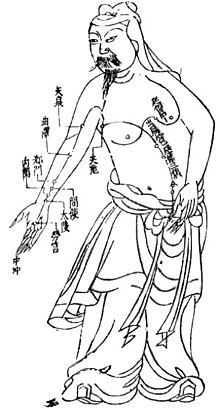
The pericardial meridian (pericardial meridian/circulatory meridian); acupuncture in the Ming dynasty (1368-1644). Bibliothèque Nationale de France, Paris
Questions and Answers
Q: What is acupuncture?
A: Acupuncture is an ancient medical treatment that involves sticking thin metal needles in specific places on a person's body.
Q: How long has acupuncture been practiced?
A: Acupuncture has been practiced for at least 2,500 years.
Q: What are acupuncture points?
A: Acupuncture points are certain places on the body where thin metal needles are inserted during acupuncture treatment.
Q: Is acupuncture considered a form of alternative medicine?
A: Yes, acupuncture is considered a form of alternative medicine.
Q: What is Traditional Chinese Medicine (TCM)?
A: Traditional Chinese Medicine (TCM) is a form of medicine that includes acupuncture and other holistic practices based on ancient Chinese philosophy.
Q: What philosophy does acupuncture use?
A: Acupuncture uses the Chinese philosophy of yin and yang.
Q: What is the purpose of acupuncture?
A: The purpose of acupuncture is to balance energy flow through the body by stimulating specific points on the body with needles, resulting in pain relief and other health benefits.
Search within the encyclopedia
